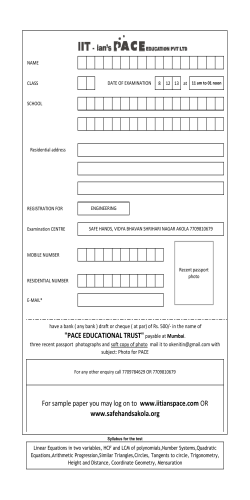
Summary From the Last Lecture • Key Exchange
Summary From the Last Lecture • Key Exchange – Diffie-Hellman – Symmetric crypto (KDC idea, Needham-Shroeder, Kerberos) – Asymmetric crypto – certificates • Stolen keys recovery • Group keys • Authentication – Something you know (passwords, handle storage, handle network transmission) – Something you have, something about you Single Sign-On • Passport • Liberty Alliance • Shibboleth Passport v1 • Goal is single sign-on – Solves problem of weak or repeated user/pass combinations • Implemented via redirections – Users authenticate themselves to a common server, which gives them tickets – Similar flavor to Kerberos but different environment – many organizations • Widely deployed by Microsoft – Designed to use existing technologies in servers/browsers (HTTP redirect, SSL, cookies, Javascript) David P. Kormann and Aviel D. Rubin, Risks of the Passport Single Signon Protocol, Computer Networks, Elsevier Science Press, volume 33, pages 51-58, 2000. How Passport Works • Client (browser), merchant (Web server), Passport login server • Passport server maintains authentication info for client – Gives merchant access when permitted by client • Divides client data into profile (address) and wallet (credit card) David P. Kormann and Aviel D. Rubin, Risks of the Passport Single Signon Protocol, Computer Networks, Elsevier Science Press, volume 33, pages 51-58, 2000. How Passport Works SSL Token = 3DES encrypted authentication info using key merchant shares with passport server Also set cookie at browser (passport) How Cookies Work • Placed into browser cache by servers to store state about this particular user – Contain any information that server wants to remember about the user as name/value pairs – May contain expiration time – May persist across browser instances • Returned to server in clear on new access • Only those cookies created for the server’s domain are sent to the server – May not be created by this server • Usually used for persistent sign in, shopping cart, user preferences Cookies for Authentication • User logs in using her user/pass – Server sets a cookie with some info – username, password, session ID … – Any future accesses return this info to the server who uses it for authentication (equivalent to user/pass) – Once user signs out the cookie is deleted and the session closed at the server • Problems – Cookies can be sniffed, remain on the browser because user did not sign out, be stolen by cross-site scripting or via DNS poisoning • Solutions: – Send cookies over SSL, use timed cookies, secure code, bind cookies to IP address of the client, encrypt cookies … Learn more at: http://cookies.lcs.mit.edu/pubs/webauth:tr.pdf David P. Kormann and Aviel D. Rubin, Risks of the Passport Single Signon Protocol, Computer Networks, Elsevier Science Press, volume 33, pages 51-58, 2000. Some Problems with Passport • User interface is confusing and may misrepresent the reality – user may log out from a server but not from the Passport or vice versa • Weak keys may be used for 3DES • Single key is used to encrypt cookies for all clients • Cookies stay on machine, can be stolen – No authenticator (timestamp) like in Kerberos, enables reuse by others Read more at http://avirubin.com/passport.html Federated Passport • Multiple federated identity providers – E.g. ISPs register own users – One can rely on claims made by other ID providers • Claims – Emails, relationships, authorization for scenarios, ownership of private/public key pair • Need “translators” for different claim languages Liberty Alliance • Similar to Federated Passport, i.e. no central authority • Use SAML (Security Association Markup Language) to describe trust across authorities, and what assertions mean from particular authorities • Four assurance levels – How much we trust a given identity assertion – Little, some, high and very high confidence Federated Identity - Shibboleth • Service Provider – Browser goes to Resource Manager who uses WAYF, and user’s Attribute Requester, and decides whether to grant access. • “Where are you from” (WAYF) service – Redirects to correct servers • Federation to form trusted relationships between providers 3. Where are you from? 2. I don’t know you, or where you are from 4. Redirect to IdP for your org Client Web Browser 1. User requests resource 8 5. I don’t know you. Authenticate using your org’s web login 1 3 5 2 Service Provider (SP) Web Site WAYF 4 6 Identity Provider (IdP) Web Site LDAP 7 8. Based on attribute values, allow access to resource 7. I don’t know your attributes. Ask the IdP (peer to peer) 6. I know you now. Redirect to SP, with a handle for user Source: Kathryn Huxtable [email protected] 10 June 2005 Generic Security Services API Moving up the Stack • Common API for client-server authentication • Standard interface for choosing among authentication methods – Once an application uses GSS-API, it can be changed to use a different authentication method easily • No code rewriting required • Dominant implementation is Kerberos – Some procedure calls • Acquire and release credentials • Manage security context – Init, accept, and process tokens (challenges) • Wrap and unwrap (encrypt/decrypt) Attacks on Password Authentication • • • • Brute force Dictionary Guessing Finding elsewhere Something You Have • Cards – Mag stripe (= password) – Smart card, USB key – Time-varying password • Issues – How to validate – How to read (i.e. infrastructure) Something About You • Biometrics – Measures some physical attribute • • • • Iris scan Fingerprint Picture Voice • Issues – How to prevent spoofing – What if spoofing is possible? No way to obtain new credentials Other Forms Of Authentication • IP Address • Caller ID (or call back) • Past transaction information – Example of something you know Multi-factor Authentication • Require at least two of the classes we mentioned, e.g. – Smart card plus PIN – RSA SecurID plus password – Biometric and password Authorization and Policy Authorization: Two Meanings • Determining permission – Is principal P permitted to perform action A on object U? • Adding permission – P is permitted to perform action A on object U • In this course, we use the first definition Access Control • Who is permitted to perform which actions on what objects? • Access Control Matrix (ACM) – Columns indexed by principal – Rows indexed by objects – Elements are arrays of permissions indexed by action • In practice, ACMs are abstract objects – Huge and sparse – Possibly distributed Example ACM File/User Tom Dick Harry Readme.txt read read read, write passwords Term.exe write read, write, execute Instantiations of ACMs • Access Control Lists (ACLs) – For each object, list principals and actions permitted on that object – Corresponds to rows of ACM File/User Readme.txt Tom: read, Dick: read, Harry: read, write passwords Harry: write Term.exe Tom: read, write, execute Instantiations of ACMs • Capabilities – For each principal, list objects and actions permitted for that principal – Corresponds to columns of ACM • The Unix file system is an example of…? User Tom Readme.txt: read, Term.exe: read, write, execute Dick Readme.txt: read Harry Readme.txt: read, write; passwords: write Problems • Permissions may need to be determined dynamically – – – – Time System load Relationship with other objects Security status of host • Distributed nature of systems may aggravate this – ACLs need to be replicated or centralized – Capabilities don’t, but they’re harder to revoke Types of Access Control • • • • • Discretionary Mandatory Rule-based Role-based Originator-controlled Discretionary Access Control • Owners control access to objects • Access permissions based on identity of subject/object • E.g., access to health information Mandatory Access Control • Rules set by the system, cannot be overriden by owners • Each object and subject has a category and a classification • Rules speak about how to match categories and classifications – Access is granted on a match Rule-Based Access Control • Individual subjects are granted access to objects if allowed by rules • Rules are set by the system administrator Role-Based Access Control • Ability to access objects depends on one’s role in the organization • Roles of a user can change – Restrictions may limit holding multiple roles simultaneously or within a session, or over longer periods. – Supports separation of roles • Maps to organization structure Originator-Based Access Control • Creator of an object decides who will access it • E.g., owner can listen to a song but cannot share it with others Authorization • Final goal of security – Determine whether to allow an operation • Depends upon – Policy – Authentication – Other characteristics The Role Of Policy • Policy defines what is allowed and how the system and security mechanisms should act • Policy is enforced by mechanism which interprets it, e.g. – Firewalls – IDS – Access control lists • Implemented as – Software (which must be implemented correctly and without vulnerabilities) Policy models: Bell-LaPadula • Focuses on controlled access to classified information and on confidentiality – No concern about integrity • The model is a formal state transition model of computer security policy – Describes a set of access control rules which use security classification on objects and clearances for subjects • To determine if a subject can access an object – Combine mandatory and discretionary AC (ACM) – Compare object’s classification with subject’s clearance (Top Secret, Secret, Confid., Unclass.) – Allow access if ACM and level check say it’s OK Policy models: Bell-LaPadula • Three security properties: – Simple Security Property - a subject at a given security level may not read an object at a higher security level (no read-up) – Star Property - a subject at a given security level must not write to any object at a lower security level (no write-down). Strong Star Property – only write to same level – The Discretionary Security Property - discretionary access control specified via an access control matrix • Trusted subjects - no star property rule – Transfer info from high clearance to low clearance Policy Models: Biba • Like Bell-LaPadula but speaks about integrity • Cannot write to higher-level objects • Subject’s integrity drops if it reads a lower-level object Security > Mix Of Point Solutions • Today’s security tools work with no coordinated policy – Firewalls and Virtual Private Networks – Authentication and Public Key Infrastructure – Intrusion Detection and limited response • We need better coordination – Not just who can access what, but policy says what kind of encryption to use, when to notify IDS • Tools should implement coordinated policies – Policies originate from multiple sources – Policies should adapt to dynamic threat conditions – Policies should adapt to dynamic policy changes GAA: Generic Authentication and Authorization Architecture INTRUSION DETECTION UNDER ATTACK Firewalls Web Servers GAA API EACL Databases IPSec Authentication … SECURITY AUDIT RECORDS GAA: Integration Through Authorization • Focus integration efforts on authorization and the management of policies used in the authorization decision – Applications shouldn’t care about authentication or identity • Separate policy from mechanism – Authorization may be easier to integrate with applications – Hide the calls to individual security services • E.g. key management, authentication, encryption, audit GAA: Extended ACLs • Positive and negative access right • Conditions on each rule - evaluated in a given order • Sample ACL (http://gost.isi.edu/info/gaaapi/eacl.html) – Tom cannot login to the host – Logins from the specified IP address range are permitted, using either X509 or Kerberos for authentication if previous login attempts <= 3. If the request fails, the number of the failed logins should be updated. The connection duration < 8 h. – Anyone, without authentication, can check the status of the host if his IP is in specified range – Host shut downs are permitted, using Kerberos for authentication. On success, the user ID must be logged. On failure, the sysadmin is sent an e-mail GAA: Conditions • Pre-conditions – What must be true in order to grant request • Request-result – These conditions must be activated regardless of whether the access is granted or not • Mid-conditions – What must be true during execution of requested operation • Post-conditions – What must be true on completion of requested operation. Three Phases of Condition Evaluation GAA-API EACL a.isi.edu, connect, Tom gaa_get_object_policy_info() gaa_check_authorization() T/F/U gaa_execution_control() T/F/U gaa_post_execution_actions() T/F/U System State What Dynamic Policies Enable • Dynamic policy evaluation enables response to attacks: – Lockdown system if attack is detected – Establish quarantines by changing policy to establish isolated virtual networks dynamically – Allow increased access between coalition members as new coalitions are formed or membership changes to respond to unexpected events Scenario - LockDown You have an isolated local area network with mixed access to web services (some clients authenticated, some not). Scenario - LockDown You have an isolated local area network with mixed access to web services (some clients authenticated, some not). You need to allow incoming authenticated SSH or IPSec connections. Scenario - LockDown • You have an isolated local area network with mixed access to web services (some clients authenticated, some not). • You need to allow incoming authenticated SSH or IPSec connections. • When such connections are active, you want to lock down your servers and require stronger authentication and confidentiality protection on all accesses within the network. Malicious Code Disclaimer • Some techniques and tools mentioned in this class could be: Dangerous – Illegal to use – Dangerous for others – they can crash machines and clog the network – Dangerous for you – downloading the attack code you provide attacker with info about your machine • Don’t use any such tools in real networks – Especially not on USC network – You can only use them in a controlled environment, e.g. DETER testbed Intrusions • Why do people break into computers? • What type of people usually breaks into computers? • I thought that this was a security course. Why are we learning about attacks?
© Copyright 2026










